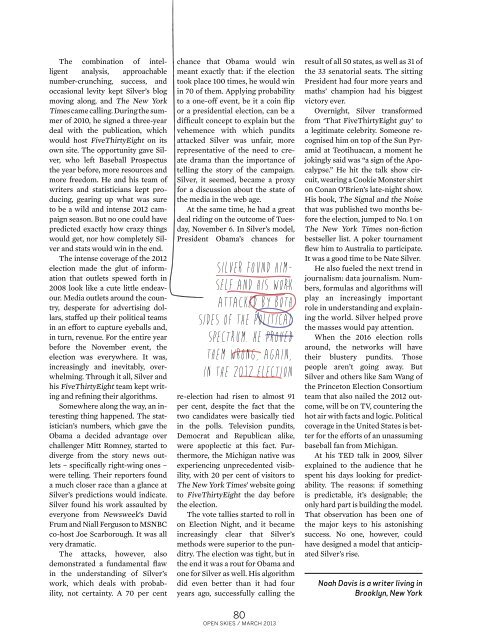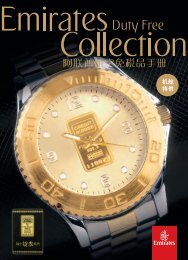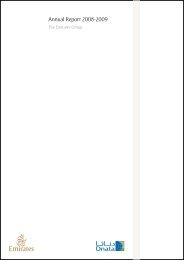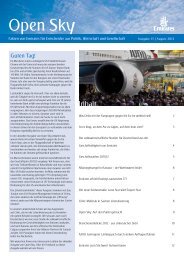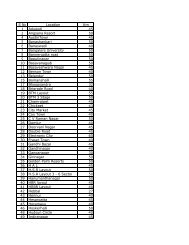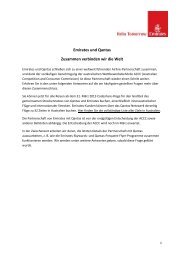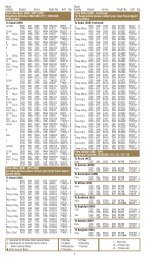Hans-Sachs-Straße - Emirates.com
Hans-Sachs-Straße - Emirates.com
Hans-Sachs-Straße - Emirates.com
You also want an ePaper? Increase the reach of your titles
YUMPU automatically turns print PDFs into web optimized ePapers that Google loves.
The <strong>com</strong>bination of intelligent<br />
analysis, approachable<br />
number-crunching, success, and<br />
occasional levity kept Silver’s blog<br />
moving along, and The New York<br />
Times came calling. During the summer<br />
of 2010, he signed a three-year<br />
deal with the publication, which<br />
would host FiveThirtyEight on its<br />
own site. The opportunity gave Silver,<br />
who left Baseball Prospectus<br />
the year before, more resources and<br />
more freedom. He and his team of<br />
writers and statisticians kept producing,<br />
gearing up what was sure<br />
to be a wild and intense 2012 campaign<br />
season. But no one could have<br />
predicted exactly how crazy things<br />
would get, nor how <strong>com</strong>pletely Silver<br />
and stats would win in the end.<br />
The intense coverage of the 2012<br />
election made the glut of information<br />
that outlets spewed forth in<br />
2008 look like a cute little endeavour.<br />
Media outlets around the country,<br />
desperate for advertising dollars,<br />
staffed up their political teams<br />
in an effort to capture eyeballs and,<br />
in turn, revenue. For the entire year<br />
before the November event, the<br />
election was everywhere. It was,<br />
increasingly and inevitably, overwhelming.<br />
Through it all, Silver and<br />
his FiveThirtyEight team kept writing<br />
and refining their algorithms.<br />
Somewhere along the way, an interesting<br />
thing happened. The statistician’s<br />
numbers, which gave the<br />
Obama a decided advantage over<br />
challenger Mitt Romney, started to<br />
diverge from the story news outlets<br />
– specifically right-wing ones –<br />
were telling. Their reporters found<br />
a much closer race than a glance at<br />
Silver’s predictions would indicate.<br />
Silver found his work assaulted by<br />
everyone from Newsweek’s David<br />
Frum and Niall Ferguson to MSNBC<br />
co-host Joe Scarborough. It was all<br />
very dramatic.<br />
The attacks, however, also<br />
demonstrated a fundamental flaw<br />
in the understanding of Silver’s<br />
work, which deals with probability,<br />
not certainty. A 70 per cent<br />
chance that Obama would win<br />
meant exactly that: if the election<br />
took place 100 times, he would win<br />
in 70 of them. Applying probability<br />
to a one-off event, be it a coin flip<br />
or a presidential election, can be a<br />
difficult concept to explain but the<br />
vehemence with which pundits<br />
attacked Silver was unfair, more<br />
representative of the need to create<br />
drama than the importance of<br />
telling the story of the campaign.<br />
Silver, it seemed, became a proxy<br />
for a discussion about the state of<br />
the media in the web age.<br />
At the same time, he had a great<br />
deal riding on the out<strong>com</strong>e of Tuesday,<br />
November 6. In Silver’s model,<br />
President Obama’s chances for<br />
Silver found himself<br />
and his work<br />
attacked by both<br />
sides of the political<br />
spectrum. He proved<br />
them wrong, again,<br />
in the 2012 election<br />
re-election had risen to almost 91<br />
per cent, despite the fact that the<br />
two candidates were basically tied<br />
in the polls. Television pundits,<br />
Democrat and Republican alike,<br />
were apoplectic at this fact. Furthermore,<br />
the Michigan native was<br />
experiencing unprecedented visibility,<br />
with 20 per cent of visitors to<br />
The New York Times’ website going<br />
to FiveThirtyEight the day before<br />
the election.<br />
The vote tallies started to roll in<br />
on Election Night, and it became<br />
increasingly clear that Silver’s<br />
methods were superior to the punditry.<br />
The election was tight, but in<br />
the end it was a rout for Obama and<br />
one for Silver as well. His algorithm<br />
did even better than it had four<br />
years ago, successfully calling the<br />
80<br />
Open skies / march 2013<br />
result of all 50 states, as well as 31 of<br />
the 33 senatorial seats. The sitting<br />
President had four more years and<br />
maths’ champion had his biggest<br />
victory ever.<br />
Overnight, Silver transformed<br />
from ‘That FiveThirtyEight guy’ to<br />
a legitimate celebrity. Someone recognised<br />
him on top of the Sun Pyramid<br />
at Teotihuacan, a moment he<br />
jokingly said was “a sign of the Apocalypse.”<br />
He hit the talk show circuit,<br />
wearing a Cookie Monster shirt<br />
on Conan O’Brien’s late-night show.<br />
His book, The Signal and the Noise<br />
that was published two months before<br />
the election, jumped to No. 1 on<br />
The New York Times non-fiction<br />
bestseller list. A poker tournament<br />
flew him to Australia to participate.<br />
It was a good time to be Nate Silver.<br />
He also fueled the next trend in<br />
journalism: data journalism. Numbers,<br />
formulas and algorithms will<br />
play an increasingly important<br />
role in understanding and explaining<br />
the world. Silver helped prove<br />
the masses would pay attention.<br />
When the 2016 election rolls<br />
around, the networks will have<br />
their blustery pundits. Those<br />
people aren’t going away. But<br />
Silver and others like Sam Wang of<br />
the Princeton Election Consortium<br />
team that also nailed the 2012 out<strong>com</strong>e,<br />
will be on TV, countering the<br />
hot air with facts and logic. Political<br />
coverage in the United States is better<br />
for the efforts of an unassuming<br />
baseball fan from Michigan.<br />
At his TED talk in 2009, Silver<br />
explained to the audience that he<br />
spent his days looking for predictability.<br />
The reasons: if something<br />
is predictable, it’s designable; the<br />
only hard part is building the model.<br />
That observation has been one of<br />
the major keys to his astonishing<br />
success. No one, however, could<br />
have designed a model that anticipated<br />
Silver’s rise.<br />
Noah Davis is a writer living in<br />
Brooklyn, New York


